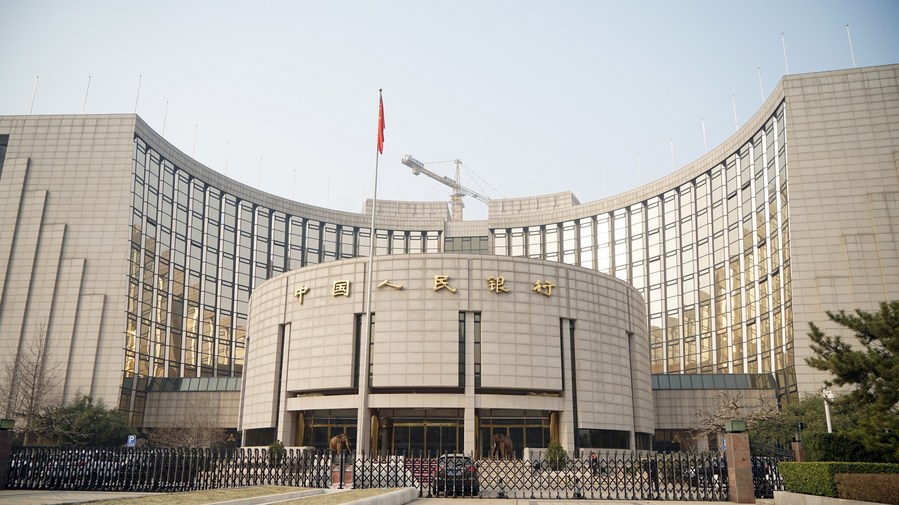
The People's Bank of China in Beijing, China. /Xinhua
The People's Bank of China in Beijing, China. /Xinhua
Editor's note: Liu Chunsheng is an associate professor at the Central University of Finance and Economics. The article reflects the author's opinion, and not necessarily the views of CGTN.
Since the beginning of 2022, in the face of the complex and severe international environment and the arduous domestic tasks of reform, development and stability, the Chinese government has effectively coordinated COVID-19 epidemic prevention and control work along with the country's economic and social development.
"More effective measures should be taken to achieve maximum effect in prevention and control with minimum cost, and to reduce the impact on economic and social development as much as possible," Chinese President Xi Jinping said at a meeting of the Standing Committee of the Political Bureau of the CPC Central Committee in March.
Shanghai and Beijing, China's two major super cities, have been affected by the epidemic, which has had a negative impact on China's economy. Under such circumstances, China's economy still achieved positive growth in the second quarter, which fully demonstrates the resilience, potential and vitality of China's economy.
Going into the second half of the year, the external environment is full of uncertainty. The conflict between Russia and Ukraine continues to impact the supply of energy and food, pushing up the global "stagflation" risk. The monetary policy of the United States and other major economies is further tightened, and global financial market volatility may increase. China will face such spillover risks as weakening foreign demand, global financial market turbulence and geopolitical conflict.
Domestic demand will become the key to stabilizing the macro-economic situation. From the perspective of domestic development, China's market is large, the industrial and supply chains are complete and scientific and technological innovation are developing rapidly. The long-term economic fundamentals for development have not changed. The short-term economic pressure mainly comes from the impact of non-economic factors.
Although the gross domestic product (GDP) growth rate in the second quarter significantly decreased, affecting the realization of the growth target of about 5.5 percent at the beginning of the year, China's stable economic operation has a solid foundation. Its consumer price index (CPI) is in the desirable range, the employment situation is generally stable, the fiscal deficit rate is relatively low, the monetary policy is prudent, and there is a large space for macro policies.
With the optimization of the coronavirus disease prevention policy, a series of economic stabilization policies will gradually come into effect, and market expectations and confidence will continue to recover. It is expected that China's economy will pick up quarter by quarter in the second half of the year, but there are challenges such as difficulties in epidemic prevention and control, insufficient market demand, and weak expectations of market players.
In the second half of the year, consumption is expected to gradually recover under the premise that the epidemic is controllable. The easing of the epidemic situation will also create conditions for the resumption of offline consumption such as accommodation, catering, culture and entertainment. Various consumption promotion activities are held in many places, and consumption coupons for energy-saving and electronic products are issued.

People visit the exhibition area of China's iconic car brand Hongqi during the 19th China (Changchun) International Automobile Expo in Changchun, capital of northeast China's Jilin Province, July 15, 2022. /Xinhua
People visit the exhibition area of China's iconic car brand Hongqi during the 19th China (Changchun) International Automobile Expo in Changchun, capital of northeast China's Jilin Province, July 15, 2022. /Xinhua
Automobile consumption is expected to gradually warm up under policy stimulus and industrial chain recovery. The policy of halving the vehicle purchase tax will strongly stimulate the recovery of automobile consumption. In addition, the current credit financing environment for residents is relatively loose. With the financial support, the purchasing ability of residents for automobiles will be improved.
The fiscal policy will continue to accelerate the recovery of infrastructure investment. In the second half of the year, infrastructure investment is expected to be an important engine for stable growth.
The effects of the policy of stabilizing the real estate market are expected to gradually appear. Therefore, real estate investment will be improved. The real estate regulatory policy is still being loosened, and it is expected that there is still room for downward adjustment of the mortgage interest rate. The real estate market will gradually warm up in the second half of the year.
In the short term, the policy of stabilizing foreign trade, the devaluation of the RMB exchange rate, and the continuous recovery of production and supply chains are conducive to China's export growth. However, China's export growth will still be under pressure in the future, and it may fall due to a gradual drop in foreign demand.
Furthermore, the exports of other export-oriented economies are growing rapidly, and some industries in China are facing the transfer of export orders. Vietnam and other Southeast Asian countries have certain competitiveness in labor-intensive industries such as textile, footwear, and electronic equipment manufacturing.
Some Chinese foreign trade orders flowed into Southeast Asia due to rising cost and the epidemic outbreak. The high price of raw materials will squeeze the profit space of foreign trade enterprises. However, China's foreign trade has shown great resilience in the first seven months and we have confidence in its performance in the second half of year.
It is imperative for the Chinese government to introduce some more powerful, accurate and effective policies to stabilize growth. The central bank should support financial institutions to carry out consumption credit business through interest discounts.
Consumption should be encouraged through appropriate government subsidies and financial institutions to grant low interest or interest-free consumer credit. On fiscal policy, in addition to continuing tax cuts and fee reductions to cut costs for small and micro enterprises, central and local governments should increase infrastructure investment to grow domestic demand.
(If you want to contribute and have specific expertise, please contact us at opinions@cgtn.com. Follow @thouse_opinions on Twitter to discover the latest commentaries in the CGTN Opinion Section.)

